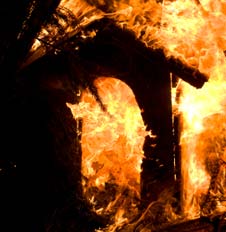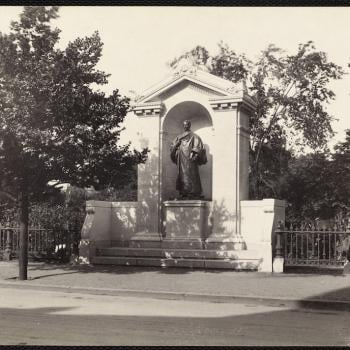There was an old woman who supported a hermit. For twenty years she always had a girl, sixteen or seventeen years old, take the hermit his food and wait on him.
One day she told the girl to give the monk a close hug and ask, “What do you feel just now?”
The hermit responded,
An old tree on a cold cliff;
Midwinter – no warmth.
The girl went back and told this to the old woman. The woman said, “For twenty years I’ve supported this vulgar good-for-nothing!” So saying, she threw the monk out and burned down the hermitage.
Case 154, Entangling Vines, translated by Thomas Yuho Kirchner
In August of 1990 I was in deep into my clinical pastoral education unit at the Pacific Presbyterian Hospital in San Francisco. It was the weekend and I was on call. As the hospital didn’t have an emergency room, I didn’t think much of it. Until I was buzzed. I called in and was told to get over as quickly as I could.
I arrived and was directed up to one of the two operating theaters. Putting on a mask I walked into the one I was directed to and was confronted with a team surrounding what I soon learned was a twelve-year old girl. No one there was interested in me, or what I had to offer.
I went to the waiting room. It was filled with family, Cambodian refugees. I announced I was the chaplain. A small woman who was surrounded by women, mostly, the men standing in an outer ring, looked up at me as what I said was translated. There was a pause. And, then she let go with a string of what I knew was invective. A slightly embarrassed looking older man said, “she’s cursing you, and God. She wants to know why?”
I wasn’t exactly sure what had happened. But, I was sure I didn’t have an answer to her why. I replied I didn’t know what had happened. But, I was here to be with her and the family for as long as they wanted. She lost interest in me. But, as the clock ran its course, others did want to talk. Some had questions, more wanted to just say something.
My spiritual practice had been mostly one of silence, and, my preparation was mostly about listening. And, well, that’s all I had, that and my bare presence. I felt terrible. But, I didn’t really have a lot of time to feel bad for myself. They were the deal.
Finally two men in scrubs came into the waiting room, an older man, and a younger one. I noticed the younger man found his shoes incredibly important. He was unable to raise his eyes. The older man took a deep breath and said they had done all they could. But, she never recovered from the heart attack. It was something congenital. No one could have foreseen. And they just couldn’t revive her.
It took a while for the family to leave. I stayed on. But, then, just as the last of them were stepping into the elevator, the doors to the other waiting room flew open. The window shades had been drawn. I hadn’t even realized anyone was there until then. But the crowd that left, some to the pay phone, others to the elevators, and still others to the stairwell were younger women and men, mostly of European descent, all I noticed dressed expensively, and Tibetan monks, both ethnically Tibetan and of European descent. They were talking rapidly, mostly in hushed tones. Many were crying.
The cacophony told me something terrible had just happened. I was confused there was no lama listed in the census, prominent or otherwise. And it wouldn’t be until Monday that I learned what had happened was that a disgraced guru who had been one of the most senior converts to Tibetan Buddhism had been there registered under his birth name, Thomas Rich, had died of complications from AIDS.
I can date this event because he is mentioned in articles and books, and dates marking his life are recorded for easy research. He died on the 25th of August 1990. The girl, I’m ashamed, I cannot even recall her name. I think about that. I write this twenty-seven years and change since that event. The child dying of a heart attack. The mother cursing me, and God. The stream of Tibetan devotees each consumed in their own grief. These images all flow together, and haunt me.
the Zen master Hakuin Ekaku once observed that “meditation in action is more important than meditation in stillness. There are appropriate and inappropriate actions in our lives. Think of it as a dance. And within the dance we all must relate to each other as precious and as valuable as I hope we come to see we are, each of us, as we are. Meditation in action.
Meditation as the burning hut. Meditation as a ring of fire.
Just as we are. I believe that we do this and truths reveal themselves. For one, all of us belong to that same great boundless family, dying child and her grieving mother, disgraced guru and his distraught disciples. One thing, empty, and bright.
And, that other thing reveals, too. You and me, just as we are, just as we are. Fleshy and messy. Angry? Lustful? Forgetful? Shy? Aggressive? Name it as yours, know it, really know it. It is the Buddha way presented.
And, so, the question. How will you act out of this place? That’s the second step. The necessary second step. Here, with this racing heart. Here, with my own actions and their consequences, it is all revealed.
No place else. There is no other place. As the monk. As the old woman. As the girl. As the dying girl. As the doctors. As the mother. As the family. As that dying guru. As that confused and lost crowd.
Life as the burning hut. Life as a ring of fire.
As the chaplain sitting with pain and confusion and wonderment.
In the burning of that hut.
Smoke rising.
Smell those ashes.
And feel the sap rising, ready to send out a new branch.













